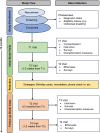Study protocol for a multimethod investigation of the development of social and nonsocial reward responsivity and depression in autistic adolescents: Reward and Depression in Autism (RDA)
- PMID: 40468369
- PMCID: PMC12139080
- DOI: 10.1186/s40359-025-02911-w
Study protocol for a multimethod investigation of the development of social and nonsocial reward responsivity and depression in autistic adolescents: Reward and Depression in Autism (RDA)
Abstract
Background: Autistic adolescents are more likely to experience depression than their non-autistic peers, yet risk factors for depression in autistic adolescents are not well understood. Better mechanistic knowledge of depression in autistic adolescents is critical to understanding higher prevalence rates and developing targeted interventions. Altered reward responsiveness and social processes, as assessed by clinical and neural measures [i.e., electroencephalography (EEG)], are important risk factors for depression in non-autistic adolescents that remain largely unexplored in autistic adolescents, even though autistic people have higher rates of depression, exhibit reward differences, and often experience difficulties in social interactions. Therefore, a multimethod investigation of social and nonsocial reward responsivity and their associations with depression symptoms in autistic adolescents, particularly over time, is needed.
Methods: The current project will employ clinical and neural measures (i.e., interviews, EEG tasks) of social and nonsocial reward responsivity and depression to test associations between these constructs in autistic adolescents for the first time. A clinical sample of 100 autistic adolescents (14-17 years old) without intellectual disability and with varying severity of depression symptoms (at least 50% with current depression) will be recruited. Clinical and neural measures will be administered at two timepoints one year apart. Planned analyses will test cross-sectional and longitudinal relations between clinical and neural measures of reward responsivity and depression symptoms.
Discussion: This systematic study of reward responsivity and depression in autistic adolescents is likely to advance our collective understanding of depression in this population by informing risk stratification models and identifying potential intervention targets. Findings may also establish the reliability of several clinical and neural measures of reward responsivity in this population that can eventually be used to measure treatment outcome and identify predictors of treatment response.
Keywords: Adolescent; Autism; Depression; Electroencephalogram; Longitudinal; Reward responsivity.
© 2025. The Author(s).
Conflict of interest statement
Declarations. Ethics approval and consent to participate: Data collection was approved by the Institutional Review Board at Children’s Hospital Los Angeles (Protocol #CHLA-22-00278). All procedures performed in studies involving human participants were in accordance with the ethical standards of the institutional and/or national research committee and with the 1964 Helsinki declaration and its later amendments or comparable ethical standards. Verbal and written informed consent and assent were collected from participants prior to the start of any study activities. Consent for publication: Not applicable. Competing interests: The authors declare no competing interests.
Figures




Similar articles
-
Autistic traits modulate mimicry of social but not nonsocial rewards.Autism Res. 2013 Dec;6(6):614-20. doi: 10.1002/aur.1323. Epub 2013 Aug 12. Autism Res. 2013. PMID: 23939872
-
Diminished social reward anticipation in the broad autism phenotype as revealed by event-related brain potentials.Soc Cogn Affect Neurosci. 2015 Oct;10(10):1357-64. doi: 10.1093/scan/nsv024. Epub 2015 Mar 9. Soc Cogn Affect Neurosci. 2015. PMID: 25752905 Free PMC article.
-
Social and nonsocial reward moderate the relation between autism symptoms and loneliness in adults with ASD, depression, and controls.Autism Res. 2019 Jun;12(6):884-896. doi: 10.1002/aur.2088. Epub 2019 Mar 2. Autism Res. 2019. PMID: 30825364 Free PMC article.
-
Folic acid supplementation and malaria susceptibility and severity among people taking antifolate antimalarial drugs in endemic areas.Cochrane Database Syst Rev. 2022 Feb 1;2(2022):CD014217. doi: 10.1002/14651858.CD014217. Cochrane Database Syst Rev. 2022. PMID: 36321557 Free PMC article.
-
Reduced reward responsiveness and depression vulnerability: Consideration of social contexts and implications for intervention.Psychophysiology. 2024 Jun;61(6):e14528. doi: 10.1111/psyp.14528. Epub 2024 Jan 23. Psychophysiology. 2024. PMID: 38263892 Free PMC article. Review.
References
-
- Gonzálvez C, Kearney CA, Jiménez-Ayala CE, Sanmartín R, Vicent M, Inglés CJ, et al. Functional profiles of school refusal behavior and their relationship with depression, anxiety, and stress. Psychiatry Res. 2018;269:140–4. - PubMed
-
- Moussavi S, Chatterji S, Verdes E, Tandon A, Patel V, Ustun B. Depression, chronic diseases, and decrements in health: results from the world health surveys. Lancet. 2007;370(9590):851–8. - PubMed
-
- Clayborne ZM, Varin M, Colman I. Systematic review and Meta-Analysis: adolescent depression and Long-Term psychosocial outcomes. J Am Acad Child Adolesc Psychiatry. 2019;58(1):72–9. - PubMed
MeSH terms
Grants and funding
LinkOut - more resources
Full Text Sources
Medical

